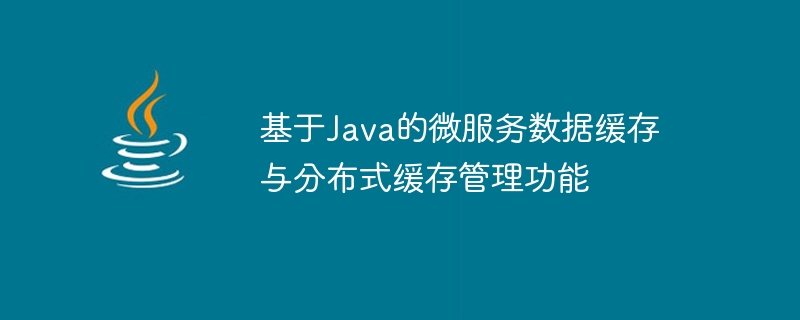基於Java的微服務資料快取與分散式快取管理功能
- WBOYWBOYWBOYWBOYWBOYWBOYWBOYWBOYWBOYWBOYWBOYWBOYWB原創
- 2023-08-10 12:25:431279瀏覽

基於Java的微服務資料快取與分散式快取管理功能
微服务架构在现代软件开发中越来越受到关注。随着微服务的快速发展,数据缓存和分布式缓存管理功能变得至关重要。在本文中,将介绍如何使用Java编写微服务中的数据缓存,并实现分布式缓存管理功能。
一、引言
数据缓存是一种将常用或热点数据存储在快速访问存储介质中的技术。它可以显著提高应用的性能和响应时间。然而,在微服务架构中,数据缓存的管理变得更加复杂,因为涉及到多个服务节点之间的数据同步和一致性保证。
二、搭建环境
在开始编写代码之前,我们需要先搭建一个适合的环境。首先,我们需要安装Java开发环境,推荐使用Java 8或以上版本。其次,我们需要选择一个合适的分布式缓存管理工具,本文将使用Redis作为示例工具。
三、实现数据缓存
首先,我们需要在微服务中使用Java实现数据缓存功能。为了简化代码,我们将使用Spring Boot来创建一个简单的微服务应用。下面是一个简单的示例代码:
import org.springframework.cache.annotation.Cacheable;
import org.springframework.stereotype.Service;
@Service
public class ProductServiceImpl implements ProductService {
@Override
@Cacheable(value = "products", key = "#id")
public Product getProductById(Long id) {
// 在这里实现从数据库或其他数据源获取Product对象的逻辑
}
}在上面的代码中,我们使用了Spring框架的缓存注解@Cacheable。这个注解告诉Spring在执行方法之前先查看缓存中是否已经存在以id为键的记录。如果存在,则直接从缓存中返回数据,否则,执行方法中的逻辑,并将结果存入缓存中。
四、分布式缓存管理
接下来,我们需要实现分布式缓存管理。使用Redis作为分布式缓存工具的原因是它具备高性能、高可扩展性和丰富的功能。
- 配置Redis依赖
首先,我们需要在项目的pom.xml文件中引入Redis的依赖:
<dependency>
<groupId>org.springframework.boot</groupId>
<artifactId>spring-boot-starter-data-redis</artifactId>
</dependency>- 配置Redis连接信息
在application.properties文件中配置Redis的连接信息:
spring.redis.host=127.0.0.1 spring.redis.port=6379 spring.redis.password=
- 启用缓存管理
启用缓存管理功能的方法很简单,只需在Spring Boot主类上加上@EnableCaching注解即可:
@SpringBootApplication
@EnableCaching
public class Application {
public static void main(String[] args) {
SpringApplication.run(Application.class, args);
}
}- 分布式缓存管理示例
import org.springframework.cache.Cache;
import org.springframework.cache.CacheManager;
import org.springframework.data.redis.cache.RedisCacheManager;
import org.springframework.data.redis.core.RedisOperations;
import org.springframework.data.redis.core.RedisTemplate;
import org.springframework.stereotype.Component;
@Component
public class DistributedCacheManagerImpl implements DistributedCacheManager {
private final CacheManager cacheManager;
public DistributedCacheManagerImpl(final RedisTemplate<String, Object> redisTemplate) {
this.cacheManager = new RedisCacheManager(redisTemplate);
}
@Override
public void put(String key, Object value) {
Cache cache = cacheManager.getCache("distributedCache");
cache.put(key, value);
}
@Override
public Object get(String key) {
Cache cache = cacheManager.getCache("distributedCache");
return cache.get(key);
}
@Override
public void remove(String key) {
Cache cache = cacheManager.getCache("distributedCache");
cache.evict(key);
}
}在上面的代码中,我们创建了一个DistributedCacheManager接口,并使用Redis实现了其具体的功能。通过注入RedisTemplate来操作Redis数据库,实现分布式缓存管理功能。
五、总结
本文介绍了如何基于Java实现微服务中的数据缓存和分布式缓存管理功能。通过使用Spring框架的缓存注解和Redis作为分布式缓存工具,我们可以方便地实现数据缓存,并保证缓存数据的一致性和高可用性。这对于提升微服务应用的性能和响应时间非常重要。通过本文的示例代码,读者可以很容易地在项目中使用这些功能,并进行进一步的扩展和优化。
以上是基於Java的微服務資料快取與分散式快取管理功能的詳細內容。更多資訊請關注PHP中文網其他相關文章!

